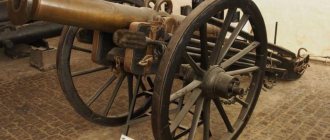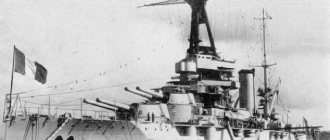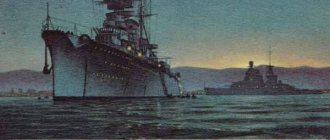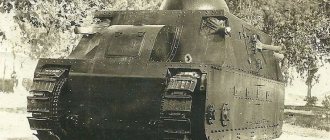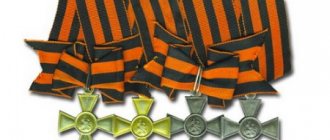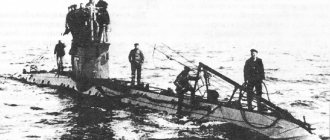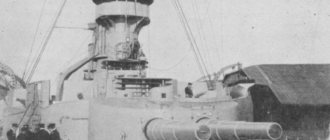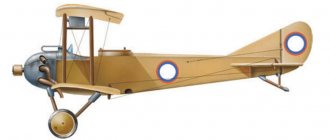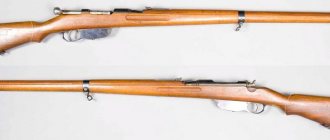The fleet on the eve and during the First World War and the Civil War: Introduction
Home / History / Fleet on the eve and during the First World War and Civil Warbased on materials from the authors - V.N. KRASNOV - Candidate of Naval Sciences, Captain 1st Rank, E.A. SHITIKOV - Candidate of Technical Sciences, State Prize laureate, Vice Admiral
The war with Japan cost Russia 2.5 billion rubles. After the war, only the cruisers Askold and Zhemchug, a gunboat and 13 destroyers remained in the Siberian flotilla. The Baltic Fleet, from which the Pacific squadrons were formed, was also seriously weakened.
Cruiser 1st rank "Memory of Azov" (1890)
The Black Sea Fleet was not affected by the Russo-Japanese War.
It had 8 squadron battleships, 2 cruisers and 4 mine cruisers. The reconstruction of naval forces remained one of the priority problems for Russia. Prominent domestic shipbuilders A.N. were involved in its solution. Krylov, N.N. Kuteynikov, I.G. Bubnov and others. A voluntary fundraiser has been announced among the population for the needs of the fleet. A “Committee to strengthen the fleet using voluntary donations” was established. Over five years, the Committee collected a substantial amount - 17 million rubles. With these funds, it was decided to build 20 destroyers of the General Kondratenko and Ukraina type. They laid the foundation for a new fleet.
| Destroyer "Novik" (1913) Total displacement 1400 tons. main dimensions 98x9.3x3.2 m maximum speed 37.5 knots. Armament 4x102 mm, 8 torpedoes |
In 1913, a significant event occurred in the development of the class of domestic destroyers.
On September 4, in St. Petersburg, the Putilov plant handed over to the fleet the lead destroyer Novik, which brought well-deserved glory to Russian military shipbuilding. For several years, Novik was the fastest ship in the world (37.5 knots). The Novika project was created in accordance with the technical specifications developed by the Marine Technical Committee under the leadership of A.N. Krylova, I.G. Bubnova, and G.F. Schlesinger.
The lead one was followed by the construction of serial ships with some elements of improvement. They were built by three factories in St. Petersburg, as well as factories in Revel, Riga and Nikolaev. By the beginning of the First World War, all Russian fleets had 75 destroyers of various types and 11 were being completed. In addition, the fleets had 45 destroyers of earlier construction. Total for 1913-1917 17 Novik-class destroyers entered the Baltic Fleet, and 14 Novik-class destroyers entered the Black Sea Fleet.
The experience of the war with Japan showed the important role of cruisers in squadron battles. The need for every possible increase in their speed and maneuverability, as well as strengthening of artillery weapons, became apparent. A subclass of battlecruisers has appeared in foreign fleets. In Russia, their construction began only in 1913-1915, when the cruisers “Izmail”, “Kinburn”, “Borodino” and “Navarin” were laid down, but the outbreak of the World War did not allow them to be completed.
And immediately after the end of the Russo-Japanese War, cruisers were built at domestic and foreign shipyards for the Russian fleet, the prototype of which was the Bayan, which had proven itself well in the role of a squadron cruiser and showed high survivability of combat and technical means. Thus, the cruiser “Admiral Makarov” was built in France, the new “Bayan” and “Pallada” were built in St. Petersburg, the cruiser “Rurik”, built in England, differed from the cruiser “Bayan” in the main caliber (instead of two 203-mm guns, four 254 mm guns).
In 1913, 6 light cruisers of the Svetlana type were laid down with a displacement of 6800-7800 tons, armed with fifteen 130 mm guns. Of these, only three cruisers (Svetlana, Admiral Nakhimov and Admiral Lazarev) were completed (during the Soviet period).
By the beginning of the war, the Russian fleet included 14 cruisers of various types.
England was the first to draw a conclusion from the defeat of the Russian fleet in the Battle of Tsushima, and, above all, from the circumstances and causes of the death of the squadron battleships. Already at the end of 1905, English shipbuilders began building the original armored ship “Dreadnought” with a displacement of about 13,000 tons, with steam turbines, classified as a battleship. The main caliber artillery on the Dreadnought consisted of ten 305 mm guns located in two-gun turrets. Four turrets, controlled from one central post, could simultaneously participate in a battleship's broadside. The side of the ship was fully armored.
Russian shipbuilders built dreadnought battleships according to the design of I.G. Bubnov and with the participation of A.N. Krylov, which surpassed the English prototype in many respects. In 1909, the battleships “Sevastopol”, “Gangut”, “Poltava” and “Petropavlovsk” were laid down at the St. Petersburg shipyards.
The linear arrangement of twelve 305-mm guns, placed in three-gun turrets, made it possible to fire from any side simultaneously with all barrels. If the weight of a salvo of one of the first English dreadnoughts “Vengard” was 3003 kg, then on “Sevastopol” it reached 5650 kg. In one minute, the domestic battleship produced up to 11.5 tons of metal and explosives. The main armor belt had a thickness of 225 mm. For the Black Sea in Nikolaev in 1915-1917. The dreadnought battleships Empress Maria, Emperor Alexander III and Catherine II were also built. The fourth battleship, Emperor Nicholas 1, laid down in 1915, was not completed.
In connection with the construction of battleships, the Russian Maritime Ministry noted that the results of testing these ships showed the full readiness of our factories, which were the first to build ships of such a significant displacement, as well as very powerful turbine-type mechanisms.
Pre-dreadnought battleships “Andrei Pervozvanny” and “Imperator Pavel 1”, laid down during the Russian-Japanese War, became part of the Baltic Fleet in 1912. During their construction, a number of significant changes were made to the original project, taking into account the experience of the past Russian- Japanese war.
The use of mine weapons in the Russo-Japanese War and its further development required the fleet to take effective measures to ensure mine defense. First of all, the fleet needed ships equipped with sweeping devices. Such ships were included in the small shipbuilding program. The world's first specially built minesweepers "Minrep" and "Vzryv" were laid down at the Izhora plant in 1909. In accordance with the tactical and technical requirements, the minesweepers had a displacement of 150 tons. The main armament of the ship were Schultz trawls (snake and boat). There was also one 57 mm gun. The ships entered service in 1911. Before the First World War and during the war, minesweepers of slightly larger displacement such as “Cluse” (190 tons) and “Capsul” (248 tons) were built.
In 1909-1910 two ships specially designed for laying mines entered service. These are minelayers “Amur” and “Yenisei” with a displacement of 2926 tons. They could take 324 mines on board. Artillery included five 120 mm guns and two 75 mm anti-aircraft guns.
For the Caspian and river flotillas, gunboats with a displacement of 600-400 tons with artillery of 120-152 mm caliber were built.
Submarine shipbuilding also gained momentum. The first combat boat “Dolphin”, designed under the leadership of I.G. Bubnova, entered service in 1904. I.G. Bubnov also designed the submarine “Akula”, which was built at the Baltic Shipyard (1910). The submarine was armed with eight torpedo tubes.
After the Akula, the Russian fleet included submarines of the Kalmar type (according to the American design), Lamprey (displacement 123/150 tons) and Walrus (displacement 630/790 tons).
However, the main core of the Russian submarine fleet was made up of Bars-class submarines, also designed by I.G. Bubnova. Their construction began in 1913-1914. in St. Petersburg and Revel. The surface displacement of the Bars was 650 tons, the underwater displacement was 782 tons. Two diesel engines with a total power of 3000 hp. allowed the submarine to develop a surface speed of 18 knots, its cruising range was within 2250 miles. In a submerged position, the full speed reached 9.6 knots. It was ensured by the operation of two electric motors with a power of 900 hp. At this speed, the submarine could travel 25 miles underwater. The working depth of immersion was limited to 50 m, the maximum -100 m. The armament consisted of four torpedo tubes (two each in the bow and stern) and two guns of 57 mm and 37 mm calibers.
A special place in the domestic submarine shipbuilding industry is occupied by the world’s first underwater minelayer “Crab” designed by M.P. Naletova. Developments on its creation, begun by the designer back in Port Arthur, were interrupted by the Russian-Japanese War. However, after the war, work was continued at the Nikolaev shipyards, and in August 1912 the ship was launched, and in June 1915 it was accepted into the Black Sea Fleet. Up to 60 minutes were taken on board the “Crab”. The armament includes two bow torpedo tubes and a 76-mm gun.
In July 1915, “Crab” made its first military campaign. Near the Bosphorus they laid a minefield, on which the enemy cruiser Breslau was blown up.
The underwater minelayers “Ruff” and “Forel” were built for the Baltic Fleet according to the “Crab” type, and three minelayers of smaller displacement were also laid down. By the beginning of the First World War, the Russian fleet had 15 combat submarines.
The main naval theaters of combat for Russia during the First World War were the Baltic and Black Seas. From the beginning of the war, the Baltic Fleet equipped the central mine and artillery position Nargen - Porkkala-Udd in order to prevent the enemy from breaking through into the Gulf of Finland. The entrance to the Gulf of Riga was covered by another mine and artillery position. With the help of mine laying in the southern part of the Baltic Sea, enemy sea communications were disrupted and damage was caused to the German fleet. It was especially important to limit the functioning of the sea route along which strategic raw materials were transported from Sweden to Germany.
The mine threat created by the Russians in the Baltic turned out to be so effective that the Germans, having lost a large number of warships and transport vessels, abandoned naval warfare for a long time at the end of 1914. During the First World War, the Baltic Fleet deployed about 40 thousand mines. An important task of the fleet was also to assist groupings of ground forces on the coastal flanks, which it successfully accomplished.
In 1915, the Black Sea Fleet was inferior in combat power to the Turkish fleet, reinforced by the German battle cruiser Goeben and the cruiser Breslau. However, later, replenished with new battleships, it was able to block the German-Turkish fleet in the Bosphorus and sharply reduce the enemy’s maritime transport. Operating on the coastal flanks. The Black Sea Fleet provided significant assistance to the army with artillery fire, supported it with landings, and provided transportation of troops and equipment. During the war years, his ships deployed more than 13 thousand mines.
During the First World War, the Russian fleet did not participate in major naval battles like Jutland. At the same time, there were numerous military clashes with the enemy of individual formations and ships of the Baltic and Black Sea fleets (battles at Cape Sarych and Gotland Island, the Moonsund operation, etc.).
Created in September 1916, the Arctic Ocean flotilla provided maritime transport with the allies and fought against enemy submarines and mine danger. After the October events of 1917, Russia withdrew from the war.
On March 3, 1918, a peace treaty was concluded between Soviet Russia on the one hand and Germany, Austria-Hungary, Turkey and Bulgaria on the other. According to the agreement, all Russian ships were subject to transfer to domestic ports or disarmament on the spot. The ships and vessels of the Baltic Fleet located in Finland were supposed to remain there until navigation began. Thus, there was a threat of loss of naval forces in this naval theater, the main core of which was concentrated in Helsingfors.
The leadership of Soviet Russia decided, despite the difficult ice situation in the Gulf of Finland, to transfer all ships to Kronstadt.
During March-April 1918, the legendary Ice Campaign of the ships of the Baltic Fleet took place. 226 ships and vessels were saved for Russia, including 6 battleships, 5 cruisers, 59 destroyers and destroyers, 12 submarines. In addition, two air fleet brigades and various military equipment were removed by ships.
In May 1918, the German command, threatening to disrupt the Treaty of Brest-Litovsk, demanded that Russia surrender its ships of the Black Sea Fleet. To prevent this, by order of V.I. Lenin in June 1918, in the areas of Novorossiysk and Tuapse, the battleship “Free Russia” (formerly “Ekaterina II”), 11 destroyers and destroyers, and 6 transports, which came here from Sevastopol, were sunk.
With the outbreak of the civil war and foreign intervention, the revolutionary-minded part of the sailors, junior commanders, officers and admirals of the fleet went over to the side of the new government, the other part, primarily admirals and officers, went over to the side of the White Army. Former commander of the Black Sea Fleet, Admiral A.V. Kolchak in November 1918 self-proclaimed himself the Supreme Ruler of Russia, leading the counter-revolutionary struggle in Siberia. Most of the ports and bases of the domestic fleet ended up in the hands of interventionists from the Entente countries and Japan. The Russian naval forces practically ceased to exist. To assist the ground forces, the commands of the opposing sides in the civil war created river and lake flotillas that conducted active combat operations. The flotillas, as a rule, included gunboats converted from steamships, armed with two to four 75-130 mm guns, as well as armed tugs, floating batteries, messengers and boats. In some cases, flotillas were replenished with ships transferred from fleets along inland waterways. The flotillas attacked the flanks and rear of the enemy, ships and vessels, defended or destroyed crossings, landed troops, and provided transportation.
After the defeat of the White Army, Lieutenant General P.M. Wrangel in the Crimea in 1920, the bulk of the ships and vessels of the Black Sea Fleet (33 pennants) under the command of Vice Admiral M.A. Kedrov went to the French naval base of Bizerte (Tunisia).
St. Andrew's flags on these ships were lowered on October 24, 1924 after the recognition of the USSR by the French government. Russian sailors switched to the status of refugees.
Battleship Dreadnought
0
London believed that Germany's naval efforts posed a great threat to Britain's strategic interests. England intensified the naval arms race. The task was set to have 60% more battleships than the Germans. Since 1905, the British began building a new type of battleship - “dreadnoughts” (after the name of the first ship of this class). They differed from squadron battleships in that they had stronger weapons, were better armored, had a more powerful power plant, greater displacement, etc.
battleship "Rostislav" enters Northern Bay 1910
0
At the beginning of the war, the Black Sea Fleet was the master of the Black Sea, since the Turkish Navy had only a few relatively combat-ready ships - 2 old squadron battleships, 2 armored cruisers, 8 destroyers. Before the war, the Turks' attempts to change the situation by purchasing the latest ships abroad were unsuccessful. At the beginning of the war, the Russian command planned to completely blockade the Bosphorus and the Turkish coast and support the troops of the Caucasian Front (if necessary, the Romanian Front) from the sea. The issue of conducting an amphibious operation in the Bosporus region to capture Istanbul-Constantinople was also considered. The situation was somewhat changed by the arrival of the newest battle cruiser Goeben and the light Breslau.” The cruiser "Goeben" was more powerful than any Russian battleship of the old type, but together the squadron battleships of the Black Sea Fleet would have destroyed it, therefore, in a collision with the entire squadron, "Goeben" retreated, taking advantage of its high speed. In general, especially after the commissioning of the Empress Maria-class dreadnoughts, the Black Sea Fleet controlled the Black Sea basin - it supported the troops of the Caucasian Front, destroyed Turkish transports, and launched attacks on the enemy coast.
"Tegetthof" in the pre-war years. Austro-Hungarian battleship of the Viribus Unitis type.
0
France. Austria-Hungary The French had 3 dreadnoughts, 20 battleships of the old type (battleships), 18 armored and 6 light cruisers, 98 destroyers, 38 submarines. In Paris they decided to focus on the “Mediterranean Front”, fortunately the British agreed to defend the Atlantic coast of France. Thus, the French saved expensive ships, because there was no great threat in the Mediterranean Sea - the Ottoman Navy was very weak and tied up by the Russian Black Sea Fleet, Italy was at first neutral and then went over to the Entente side, the Austro-Hungarian fleet chose passive strategy. In addition, there was a fairly strong British squadron in the Mediterranean.
0
The Austro-Hungarian Empire had 3 dreadnoughts (the 4th entered service in 1915), 9 battleships, 2 armored and 10 light cruisers, 69 destroyers and 9 submarines. Vienna also chose a passive strategy and “defended the Adriatic”; the Austro-Hungarian fleet remained in Trieste, Split, and Pula for almost the entire war.
squadron battleship "Slava"
0
It should be noted that the Western European fleets in the pre-war years paid little attention to the submarine fleet. This is due to two main reasons. Firstly, previous wars had not yet revealed their combat significance; only in the First World War did their enormous significance become clear. Secondly, the then dominant naval doctrine of the “high seas” assigned submarine forces one of the last places in the struggle for the sea. Dominance in the seas was to be won by battleships, having won a decisive battle.
"Beowulf"
0
The combat effectiveness of the German Navy was affected by the lack of autocracy. The main creator of the fleet was Grand Admiral Alfred von Tirpitz (1849 – 1930). He was the author of the "risk theory", which stated that if the German fleet was comparable to the English in strength, then the British would avoid conflicts with the German Empire, because in the event of war, the German Navy would have a chance to inflict sufficient damage on the Grand Fleet for the British fleet to lose supremacy at sea. With the outbreak of the war, the role of the grand admiral declined. Tirpitz became responsible for the construction of new ships and the supply of the fleet. The High Seas Fleet was led by Admiral Friedrich von Ingenohl (1913-1915), then Hugo von Pohl (from February 1915 to January 1916, before that he was Chief of the General Naval Staff), Reinhard Scheer (1916-1918). In addition, the fleet was the favorite brainchild of the German Emperor Wilhelm; while he trusted the generals to make decisions about the army, the Navy was managed by himself. Wilhelm did not dare to risk the fleet in an open battle and allowed only a “small war” to be waged - with the help of submarines, destroyers, and mine laying. The battle fleet had to adhere to a defensive strategy.
battleship "Tsesarevich"
0
Russia The Russian fleet under Emperor Alexander III was second only to the navies of England and France, but then lost this position. The Russian Navy received a particularly big blow during the Russo-Japanese War: almost the entire Pacific squadron and the best ships of the Baltic Fleet, sent to the Far East, were lost. The fleet needed to be restored. Several naval programs were developed between 1905 and 1914. They provided for the completion of 4 previously laid down squadron battleships, 4 armored cruisers and the construction of 8 new battleships, 4 battleships and 10 light cruisers, 67 destroyers and 36 submarines. But by the beginning of the war, not a single program had been fully implemented (the State Duma also played a role in this, which did not support these projects).
"Boyarin"
0
For the first time, Russian dreadnoughts of the Sevastopol type used a system for installing not two, but three-gun turrets of the main caliber. In England and Germany, they were initially skeptical about the idea, but the Americans appreciated the idea and Nevada-class battleships were built with three-gun turrets. In 1912, 4 Izmail-class battlecruisers were laid down. They were intended for the Baltic Fleet. These would be the most powerful battlecruisers in the world in terms of artillery armament. Unfortunately, they were never completed. In 1913-1914, eight light cruisers of the Svetlana class were laid down, four each for the Baltic and Black Sea fleets. They were going to be put into operation in 1915-1916, but did not have time. Russian Bars-class submarines were considered one of the best in the world (they began to be built in 1912). A total of 24 Bars were built: 18 for the Baltic Fleet and 6 for the Black Sea.
"Queen Elizabeth" - the lead ship of the Queen Elizabeth series super-dreadnoughts
0
Germany responded by building its own dreadnoughts. Already in 1908, the British had 8 dreadnoughts, and the Germans had 7 (some were in the process of completion). The ratio for “pre-dreadnoughts” (squadron battleships) was in favor of Britain: 51 against 24 German ones. In 1909, London decided to build two of its own for every German dreadnought. The British tried to maintain their naval power through diplomacy. At the Hague Peace Conference in 1907, they proposed limiting the scale of construction of new warships. But the Germans, believing that this step would only benefit Britain, rejected this proposal. The naval arms race between England and Germany continued until the First World War. By its beginning, Germany had firmly taken the position of the second military naval power, overtaking Russia and France. Other great powers - France, Russia, Italy, Austria-Hungary, etc., also tried to build up their naval armaments, but due to a number of reasons, including financial problems, they were unable to achieve such impressive successes.
0
The fleets were required to perform a number of important tasks. Firstly, to protect the coasts of countries, their ports, important cities (for example, the main purpose of the Russian Baltic Fleet is to protect St. Petersburg). Secondly, the fight against enemy naval forces, supporting one's ground forces from the sea. Thirdly, the protection of sea communications, strategically important points, especially for Britain and France, they owned huge colonial empires. Fourthly, to ensure the status of the country, a powerful navy showed the position of the power in the world informal table of ranks.
The world's first underwater minelayer - the submarine "Crab" (Russia, 1912).
0
Russian railway engineer Mikhail Petrovich Nalyotov was the first to realize the idea of a submarine with anchor mines. Already in 1904, during the Russo-Japanese War, participating in the heroic defense of Port Arthur, Nalyotov, at his own expense, built a submarine with a displacement of 25 tons, capable of carrying four mines. Conducted the first tests, but after the surrender of the fortress the device was destroyed. In 1909-1912, a submarine called “Crab” was built at the Nikolaev shipyard. She became part of the Black Sea Fleet. During the First World War, the "Crab" made several combat missions with mine laying, even reaching the Bosporus.
0
Already during the war, Russia became a world leader in the use of hydrocruisers (aircraft carriers), fortunately, this was facilitated by the factor of dominance in the creation and use of naval aviation. Russian aircraft designer Dmitry Pavlovich Grigorovich, since 1912 he worked as the technical director of the plant of the First Russian Aeronautics Society, in 1913 he designed the world's first seaplane (M-1) and immediately began to improve the aircraft. In 1914, Grigorovich built the M-5 flying boat. It was a two-seat biplane of wooden construction. The seaplane entered service with the Russian fleet as a reconnaissance aircraft and artillery fire spotter, and in the spring of 1915 the aircraft made its first combat mission. In 1916, Grigorovich's new aircraft, the heavier M-9 (naval bomber), was put into service. Then the Russian genius designed the world's first fighter seaplane, the M-11.
